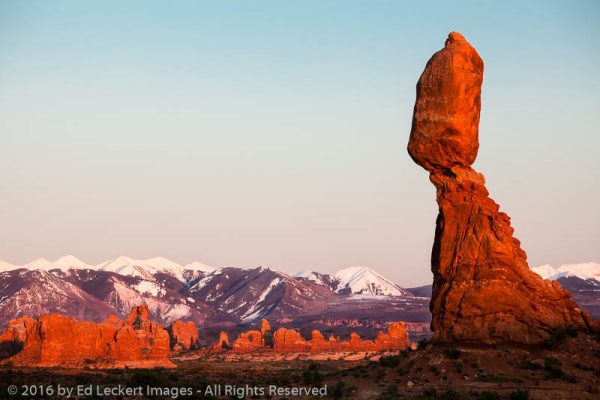


National Parks are beautiful during the day, but when nighttime arrives, they can become magical!
Last week in Arches and Canyonlands we had just finished a morning shoot at Dead Horse Point State Park, and I mentioned that soon we would be doing some nighttime and early morning photography in both Arches and Canyonlands National Parks. Well, that day had arrived, and it was time to make final plans for that evening.
After spending the day exploring and doing some macro photography with desert wildflowers, we headed to a place called Balanced Rock in Arches NP. Balanced Rock is exactly what it sounds like – a rock sitting up high in an unlikely pose, seemingly ready to crash down at any moment.
Our goal was to try to photograph the rock formation with the Milky Way in the background. Arches NP is in an area that is fairly free of light pollution, at least so far, making it an ideal place for astrophotography.
We arrived at Balanced Rock in the late afternoon to scout out the area and decide where we wanted to be shooting that evening. Trust me, this is much easier to do while it’s still light rather than show up in the middle of the night and stumble around with a headlamp, annoying other photographers and almost falling off a cliff or something. (Yes, I speak from experience.)
As we were exploring different angles, the sun was setting in a clear western sky, casting a beautiful orange light on the already colorful sandstone that dominates the landscape in this area. So of course we put our cameras to work capturing this light, all the time wishing the completely clear sky had been more interesting, but also realizing that this clear sky would be exactly what we needed to capture the stars at their best later that evening.

Balanced Rock catches the late afternoon sunlight as Turret Arch and the Windows Section is visible in the background, at Arches National Park, Utah.
When the sun had set, we headed back to Moab for dinner and a quick nap, knowing it would be a long night.
At just before 2:00 AM, we returned for our nighttime shoot. We chose this time based on our calculations as to where the Milky Way would be in the sky relative to the rock formations.
Just a few years ago, when my friend Jeremy and I were lucky enough to have one of the few camera models that were optimal for this type of photography, we could show up just about anywhere at night and have the place to ourselves. Not so anymore. When we arrived at the Balanced Rock parking lot, I knew to dim my headlights down to the daylight running lights out of respect for the photographers we knew would already be there. And they certainly were. I wouldn’t say the parking lot was full, but it was certainly far from empty. As we got out and gathered our gear, we could see headlamps all around the nearby rock formations, and heard the voices of photographers coordinating their light painting efforts.
Good astrophotography requires an interesting earth-bound object in the foreground, and silhouettes don’t cut it anymore. The object must be lit creatively to produce a compelling image, and without an existing light source such as the moon or some kind of fixed artificial lighting, that usually means light painting will be necessary. Astrophotography requires longer exposures of several seconds to several minutes, depending on the situation, and these long exposures allow plenty of time for the photographer to “paint” the foreground object with a flashlight or headlamp. You begin the exposure, turn on the light, and sweep it quickly back and forth across all areas of the foreground object, being careful not to light anything you don’t want in the image, such as anything unsightly or that would make the image cluttered.
While we had our own lights, we didn’t really expect to have to use them – there were already enough photographers there lighting the rock for us. All we had to do was listen.
“Ready?”.
“No, hang on. OK, go!”
Beep…beep…beep…click…
Then a light would begin sweeping across the rocks. As long as you had your shutter open during some or all of this cycle, you were bound to get something. Do it enough times and you’ll probably have something you can work with.
So we got our Milky Way images. We stayed there until about 3:00 AM, at which point the Milky Way was getting a bit high in the sky for our liking. At that point it was time to move on to our next shooting location in Canyonlands National Park. Remember Mesa Arch? Check back next week to see how that went!

The Milky Way shot is a keeper Ed!